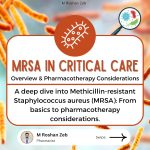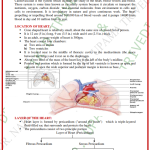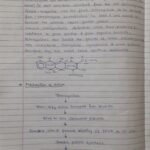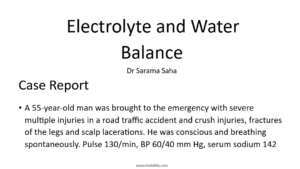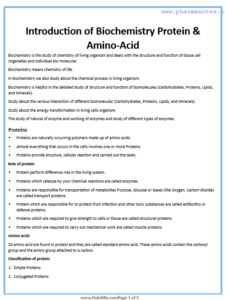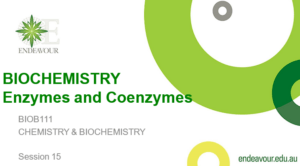ZO503 ANIMAL PHYSIOLOGY AND
PHYSIOLOGICAL CHEMISTRY
BLOCK – III: PHYSIOLOGICAL CHEMISTRY
Dr.Shyam S.Kunjwal
Department of Zoology
Uttarakhand Open University
Haldwani
INTRODUCTION TO LIPIDS
Lipids are a very important heterogonous group of organic substances which are widely distributed
throughout the plant and animal kingdom. The plant they are present in seeds, nuts and fruits, while in
animals they are stored in adipose tissues, bone marrow and nervous tissues. Chemically they are
various types of esters of fatty acids and alcohol. The addition to fatty acids and alcohols, some of the
lipids may contain phosphoric acid, nitrogenous group and carbohydrate. Lipids are relatively
insoluble in water and readily insoluble in water and readily soluble in organic solvents such either,
chloroform, carbon disulphide benzene, hot alcohol etc. Bloor [1947] defined lipids as “naturally
occurring compound which are insoluble in water, and soluble in one or more organic solvent such as
benzene, chloroform, either acetone the so called fat solvent on hydrolysis field fatty acids which are
utilized by the living organisms’’
10.10 CLASSIFICATION OF LIPIDS
Lipids are generally classified into three main classes
1. Simple Lipids
2. Compound Lipids
3. Derived Lipids
Fig.10.10. Classification of Lipids
10.10.1 SIMPLE LIPIDS
Simple lipids are the esters of fatty acids with various alcohols. These can be further categorized into
fats and waxes. Fats are triesters of glycerol and fatty acids. A fat in the liquid state is called oil.
Waxes are the esters of fatty acids with long chain (higher mol.wt.) monohydric alcohols.
Fats
Fats are solids at room temperature. Chemically, fats are triglycerides since, three molecules of fatty
acids condense with one molecule of glycerol, e.g. three molecules of stearic acid are linked to
glycerol to yield glyceryl tristearate, a fat.
If all the three molecules of fatty acids are similar, the product is a simple glyceride. If fatty acids
molecules are different, it is called a mixed glyceride. Natural fats are largely composed of mixed
glycerides. Since these glycerides have no acid or basic groups, they are often called natural fats. The
melting point of fats depends upon the chain length and degree of saturation of fatty acids. The
melting points of fats are always higher than the solidification point, e.g. tristearin melts at 720C but
solidifies on cooling at 520C.
Fats develop unpleasant odor on aging, this is due to auto oxidation of fat. This is called
rancidification.
The chemical changes that occur during rancidification are called rancidity. Fats which are liquid at
room temperature are called oils. Oils are also esters of fatty acids and glycerol, but the fatty acids
found in oils are unsaturated fatty acids. The unsaturated fatty acids have one or more double bonds.
They have low melting point and are insoluble in water. Hydrolysis of fats with alkali or enzymes
lipase yields fatty acids and glycerol. When the fats are hydrolyzed with alkali, the few fatty acids
react with alkali to form salts. These salts are soaps and this process is called saponification.
Waxes
Waxes are another class of simple lipids. These are the esters of fatty acids with high molecular weight
alcohol. Waxes contain one molecule of fatty acids and one molecule of alcohol. The bees wax, the
fatty acid constituent is a smaller chain acid, palmitic acid and [160C] and alcohol is myristic
palmitate. Ambretolide found in the seeds of abelmoschus esculentus is a hay hydro nil acid and is
responsible for the characteristic smell of the seed. Being highly insoluble in water and having no
double bonds in their hydrocarbon chains, waxes are chemically insert. And very resistant to
atmospheric condition also not digested by the fat splitting enzymes. They can be split slowly with hot
alcoholic KOH, however. They also have higher melting point. They serve as protective coating on
fruits and leaves. They play on important role in provide water barrier for insects, birds and animals.
They are used in furniture polishing.
Fatty Acids
Fatty acids are obtained from the hydrolysis of fats. Since all the fats contain glycerol, their properties
differ according to the nature of fatty acids present in them. A fatty acid can be defined as an organic
acid that occurs in a natural triglyceride and is a monocarboxylic acid ranging in chain length from C4
to about 24 carbon atoms. A few have branched chain or contain hydromel group or have a cyclic
chain at the end. Fatty acids that occur in natural fats usually contain an even number of carbon atoms,
one carboxylic group and are straight chain derivatives. On the basis of presence or absence of double
bonds, fatty acids may be classified into two main classes-
i. Saturated fatty acids (saturated with hydrogen)
ii. Unsaturated fatty acids
1. Saturated fatty acids
The fatty acids which do not contain any double bond are called saturated fatty acids. The general
formula is Cn H2n+1 COOH e.g. Butyric acid C3 (CH2)2 COOH. The most abundant saturated fatty
acids in nature are palmitic acid (C18) and stearic acid (C16). The saturated fatty acids are straight chain
acids. In addition to these straight chain acids, there are some branched chain acids, with odd or even
number of carbon atoms.eg. Isopalmitic acid, anti-isopalmitic acid and tuberculostearic acid.
2. Unsaturated fatty acids
The fatty acids which contain one or more double bonds are called unsaturated fatty acids. On the
basis of number of double bonds, the unsaturated fatty acids may be divided into two groups-
Monosaturated fatty acids: – having one double bond e.g. crotonic acid, oleic acid, palmitoleic acid,
nervonic acid etc.
Polyunsaturated fatty acids:-having more than one double bonds e.g. linoliec acid, eleostearic acid etc.
In most of the monosaturated fatty acids there is a single bond lying between carbon atoms 9 and 10.
This is designated as ∆9. The symbol ∆ with the superscript number nine (9) indicates the positions of
the double bond. When there are more than one double bond (polyunsaturated fatty acids), the
additional bonds occur between the ∆9 double bond and the methyl terminal end of the chain. The
symbol 18:3 signifies that there are three double bonds and symbol ∆9,12,15 signifies that the position of
double bonds are between carbon atom 9 and 10, 12 and 13 and 15 and 16. Presences of double bonds
in the fatty acids lower their melting point considerably. Most plant fats contain unsaturated fatty acids
as oleic acid and linoleic acid and hence they are liquid at room temperature. Contrary to this animal
fats have more of saturated fatty acids and hence solid at room temperature.
Essential and Non Essential Fatty Acids
Essential fatty acids: The fatty acids which cannot be synthesized by human body but are essential for
the normal maintenance of the body are called essential fatty acids .These fatty acids must be included
in our diet. Three polyunsaturated fatty acids, linoleic acid, linolenic acid and arachidonic acid are the
essential fatty acids.
Non essential fatty acid: These are the fatty acids which can be synthesized by our body. Thus they
need not be included in our diet. They are unsaturated fatty acids and are synthesized from their
corresponding saturated fatty acids by introducing a single bond .e.g. palmitoleic acid and oleic acid.
10.10.2 COMPOUND LIPIDS
Compound lipids contain some additional groups or elements besides fatty acids are alcohol. The
addition group may contain phosphorus, nitrogen, sulpher or it may be a protein. Compound lipids can
be categorized into the following: Phospholipids, Glycolipids, Other compound lipids.
Phospholipids
Phospholipids are those compound lipids which contain a phosphorus atom. Phospholipids are wide
spread in bacteria, animal and plant tissues and their general structures are quiet similar. These have
been termed as amphipathic and compound since they process both polar and non polar function.
In addition to phosphorus, phospholipids may also contain nitrogen as a key component. There are
various types of phospholipids including- lecithin, cephalins, plasmalogens, phosphoinositides and
phosphosphingosides.
Lecithin
Lecithin is widely distributed in nature. In animals it is found in liver, brain, nerve tissues, sperm and
egg yolk. In plant it is abundant in seeds and sprouts. On hydrolysis, lecithin yields glycerol, fatty
acids, phosphoric acid and nitrogenous base – choline. It is also called phosphatidyl choline. The fatty
acids commonly found in lecithin are palmitic, stearic, oleic, linolenic and arachidonic acids. Lecithin
is yellowish grey solid which is soluble in with soluble in ether and alcohol but insoluble in acetone.
On exposure to air they rapidly darken colour and absorb water, forming dark grassy mass. Lecithins
are broken down by the enzyme lecithinase to lysolesithin which is present in venoms of bee and
cobra. When injected into the blood, lysolecithins cause rapid haemolysis of the red blood cells.
Cephalins
Cephalins are found in animal tissues in close association with lecithin. They are also found in soya
bean oil. The basic difference between cephalins and lecithin is the nature of nitrogenous base.
Cephalins contain ethanolamine in place of choline. The fatty acid components of cephalins are
stearic, oleic, linoleic and arachidonic acid. They are less soluble in alcohol then lecithin.
PLASMALOGENS
Plasmalogens are abundant in brain and muscles they are also found in the seeds of higher plants.
Structurally, they resemble lecithin and cephalins except in having an aldehyde group attached to ex –
carbon atoms of glycerol. They are soluble in all lipid solvents.
Plasmalogen
Phosphoinositides
They are present in brain tissues and nervous tissues. They can be either mono or diphosphoinositides.
Monophosphoinositides contain hexahydric alcohol inositol. The name lipoinosital was also proposed
for them.
PHOSPHOSPHINGOSIDES
These lipids are abundant in lacking in plant and microorganisms. In these lipids glycerol is replaced
by an 18 carbon unsaturated amino alcohol called ‘sphingosine’. On hydrolysis they yield fatty acids,
phosphoric acid, choline and sphingosine.
Glycolipids
Glycolipids are compounds containing carbohydrates and high molecular weight fatty acids like
sphingosine but no phosphoric acid. These are of two types: Cerebrosides and Gangliosides.
Cerebrosides: They occur in large amount in brain and myelin sheath of nerves. The structure of
cerebrosides is somewhat similar to sphingomyelin. Here the fatty acid ceramide is linked either to
galactose or glucose.
Gangliosides: These are found in ganglion cells of nervous tissues and also in parenchymatous tissues
like spleen and RBCS, They are the most complex glycosphingolipids. They are ceramides with
attached oligosaccharides that include at least one sialic acid residue.
Other compound lipids
Sulfolipids: Lipids containing sulfer, widely distributed in plant (localized in chloroplast) and bacteria.
Lipoprotein: They are the component of membranes found in the membranes of mitochondria, ERL
The lipid component consists of triacylglycerol, phospholipids and cholesterol. The protein
components of lipoprotein have a relatively high portion of non polar acid residues.
10.10.3 DERIVED LIPIDS
Derived lipids are the product of hydrolysis of simple lipids and compound lipids and in addition other
lipid like compounds such as steroids, terpenes, fatty acids, alcohols, carotenoids, essential oils etc.
Steroids
Steroids are the derivatives of cyclopentanoperhydrophenanthrene, a compound consisting of four
fused non planer rings. They are named as A, B, C and D. The rings A, B and C are hexagons and are
called cyclohexane rings while D is a pentagon and is called cyclopentane.
Sterols
The steroids may have one or more alcoholic groups. The steroids having alcoholic groups are called
sterols. They are crystalline compounds and differ from alcohols in being solids that is the reason they
are called so. Steroids are widely distributed in plant, animals and microorganism. They are found in
cell membranes and other cellular component containing lipids. Unlike other lipids, sterols cannot be
saponified and by this process they can be separated from other lipids. Ergosterol is present in food in
small amount. It has been isolated from parasitic fungus Claviceps pupurea (Ergon) growing on rye
plants. Other plant sterols are spinasterol obtained from spinach and cabbage, stigmasterol from
coconut and soyabeans and sitosterol from cereal seeds.
Cholesterol
The best known animal sterol is cholesterol, which is a major component of animal plasma membrane.
It is classified as sterol because of its C30H group It is present in relatively high concentration in
nervous tissues and in bile. Cholesterol is a crystalline solid with rhombic crystals and its solution is
levorotatory. It has a high melting point.
In mammals, cholesterol is the metabolic precursor of steroid hormones – adrenocorticoids and sex-
steroids.
Adrenocorticoids
They are secreted by the adrenal cortex hormone contains – glucocorticoids, aldosterone, cortisterone,
desoxycortisterone adrenosterone and other mineral corticoids influence a wide variety of vital
functions.
Sex steroids
The testes secrete testosterone, andosterone and adrenosterone, while estrogens and progesterone are
secreted by the ovary. They affect sexual development and functions.
10.11 SOURCES OF LIPIDS
Lipids are widely distributed in plants and animals. Common sources of fatty acids are butter, coconut
oil, animal fats and some bacteria. Lecithin, a type of phospholipids is found in liver, brain, nerve
tissue, sperm and yolk sac in animals while in plants it is abundant in seeds and sprouts. Similarly
other phospholipids and glycolipids are also found in animal tissues like brain, muscles and nervous
tissues. Terpenes and carotinoids are types of derived lipids which are exclusively of plant origin.
10.12 BIOLOGICAL SIGNIFICANCE OF LIPIDS
1. Rich source of energy: fats provide food of high calorific value (1g fat produces about 9.3 kilo
calories of heat).
2. As food reserve: Fats are stored in body as reserve food material, because these could be
readily stored in the body on account of insoluble character sticks. Triglycerides stored in
adipocytes (fat cells) of adipose tissue are the principal fat reserve.
3. As heat insulators: Fats deposited in the subcutaneous tissues act as insulators conserving body
heat.
4. Solvent: Lipids act as a solvent for fat soluble vitamins like vitamin A, D and E.
5. Structural constituents: Phospholipids, glycolipids and sterols are structural components of all
the membrane system of cell (i.e. cell membrane, nuclear membrane, membranes of the
endoplasmic reticulum etc.)
6. Fat transport: Phospholipids play an important role in the absorption and transportation of fatty
acids.
7. Hormone synthesis: Adrenocorticoids, sex hormones, vitamin D and cholic acids are
synthesized from cholesterol.
8. As shock absorber: The fat deposited around the visceral organs and underneath the skin acts
as cushion and absorbs mechanical shocks.
9. As electric insulators: Myelin sheath around medullated nerve fibres forms an electric
insulation.
10. Prostaglandins: They control local activities in the body.
11. Protective layers: Lipids form a protective waxy covering on the aerial parts of plants to check
loss of water by evaporation.
12. Thrombokinase: helps blood clotting.
13. Leukotrienes: a group of eicosanoid helps in respiration.
14. Some isoprenoids form insect hormones.
15. Some insoprenoids form volatile oil and pigments. Natural rubber is also an isoprenoid.
16. Glycolipids help in cell recognition.
17. Complex lipids form phospholipid bilayer of plasma membrane.
18. Steroid act as hormones and neurotransmitters in mammals.
10.13 DEFICIENCY DISEASES OF LIPIDS
The deficiency of lipids in human body causes dry, scaly skin, hair loss, loss of mensuration, cold
intolerance, power resistance to infection and bruising, poor growth, poor wound healing and low
body weight.
10.14 SUMMARY
Carbohydrates are the compounds of carbon, hydrogen and oxygen are the major source of
energy in body.
Carbohydrates are classified into three major groups- monosaccharides, oligosaccharides
and polysaccharides.
Monosaccharides are the simplest carbohydrates and are either aldoses or ketoses.
Oligosaccharides consist of few molecules of monosaccharide, most common are
disaccharides consist of two molecules of monosaccharides.
In polysaccharides a number of monosaccharides are linked by glycosidic bonds.
Polysaccharides maybe either homopolysaccharide or heteropolysaccharide.
Monosaccharides are colourless and crystalline compounds which are optically active.
Lipids are a heterogeneous group of molecules with are soluble in organic solvents.
Chemically lipids are the esters of fatty acids with alcohols.
Lipids are good source of energy and important constituent of biological membranes.
Lipids are generally classified into simple, compound and derived lipids. Fats and wax are
simple lipids.
Fatty acids are obtained from the hydrolysis of fats and can be saturated or unsaturated.
Phospholipids are the compounds lipids which contains a phosphorus group.
Glycolipids contain carbohydrate and high molecular weight fatty acids.
Derived lipids are the products of hydrolysis of simple and compound lipids and include
steroids, terpenes, carotenoids etc.


